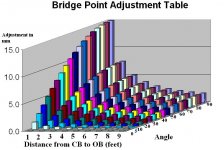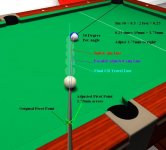I just thought up a new aiming system which some may find useful. Not sure if anyone has proposed this method before, but it wouldn't suprise me if they had.
The purpose of it is to be mathematically accurate for all angles but also easy and consistant in its methodology.
It requires just 2 points, the OB contact point which is relatively easy to see and the CB center point. Much like the basic erroneous system many of us learned when we first started.
But as we know, this system alone means angled shots are hit too thick. So there is a mathematical method of adjustment which is key to this system.
The adjustment is done by moving the bridge point according to the formula:
Distance of Movement = (sine of angle / length of shot in feet) x 15mm.
So you need to be able to estimate the angle of the shot within 5 degrees. Not so hard with some practice. And then know the sine of this angle, which can be easily estimated from this guide:
Sine of Various Cut Angles
90...1
80...0.98
70...0.94
60...0.87
50...0.77
45...0.71
40...0.64
30...0.5
20...0.34
10...0.17
0....0
Also, this formula is based on an 8" bridge length, it can be adjusted for different bridge lengths. For example a 6" bridge length the multiplying factor would be about 12mm, for a 12" bridge length you would multiply by about 20mm. This doesn't need to be exact. Rounded off numbers will work well within the margin or error of most pots.
So, for a half ball shot (30 degrees) with CB 3 feet from the OB you would line the Center of the CB to the Contact Point on the OB and move your bridge point across this amount: (for an 8" bridge)
sin30 = 0.5 divided by 3 feet = 0.167 x 15mm = approx 2.4mm
Now if your bridge is at your pivot point you can fire away with any side english you want from here. If you want center CB contact then just pivot the cue from this point to the center of the OB.
Let's imagine you have an 8 foot shot with an 80 degree cut:
Sin80 = 0.98 / 8 feet = 0.12 time 15mm = approx 1.7mm
So line up to the contact point and adjust bridge almost 2mm in the appropriate direction and fire away.
Now lets imagine a 60 degree cut from 15 inches away.
Sin60 = 0.87 / 1.25feet = about 0.7 times 15mm = 10.5mm (almost one tip width).
With some practice you should be able to estimate the angles well enough and remember the sine conversions close enough.
This system should give better accuracy than the HH 3 point system I believe.
Give it a try and let me know your results.
If you want to understand the math more clearly, just ask.
Colin
The purpose of it is to be mathematically accurate for all angles but also easy and consistant in its methodology.
It requires just 2 points, the OB contact point which is relatively easy to see and the CB center point. Much like the basic erroneous system many of us learned when we first started.
But as we know, this system alone means angled shots are hit too thick. So there is a mathematical method of adjustment which is key to this system.
The adjustment is done by moving the bridge point according to the formula:
Distance of Movement = (sine of angle / length of shot in feet) x 15mm.
So you need to be able to estimate the angle of the shot within 5 degrees. Not so hard with some practice. And then know the sine of this angle, which can be easily estimated from this guide:
Sine of Various Cut Angles
90...1
80...0.98
70...0.94
60...0.87
50...0.77
45...0.71
40...0.64
30...0.5
20...0.34
10...0.17
0....0
Also, this formula is based on an 8" bridge length, it can be adjusted for different bridge lengths. For example a 6" bridge length the multiplying factor would be about 12mm, for a 12" bridge length you would multiply by about 20mm. This doesn't need to be exact. Rounded off numbers will work well within the margin or error of most pots.
So, for a half ball shot (30 degrees) with CB 3 feet from the OB you would line the Center of the CB to the Contact Point on the OB and move your bridge point across this amount: (for an 8" bridge)
sin30 = 0.5 divided by 3 feet = 0.167 x 15mm = approx 2.4mm
Now if your bridge is at your pivot point you can fire away with any side english you want from here. If you want center CB contact then just pivot the cue from this point to the center of the OB.
Let's imagine you have an 8 foot shot with an 80 degree cut:
Sin80 = 0.98 / 8 feet = 0.12 time 15mm = approx 1.7mm
So line up to the contact point and adjust bridge almost 2mm in the appropriate direction and fire away.
Now lets imagine a 60 degree cut from 15 inches away.
Sin60 = 0.87 / 1.25feet = about 0.7 times 15mm = 10.5mm (almost one tip width).
With some practice you should be able to estimate the angles well enough and remember the sine conversions close enough.
This system should give better accuracy than the HH 3 point system I believe.
Give it a try and let me know your results.
If you want to understand the math more clearly, just ask.
Colin

